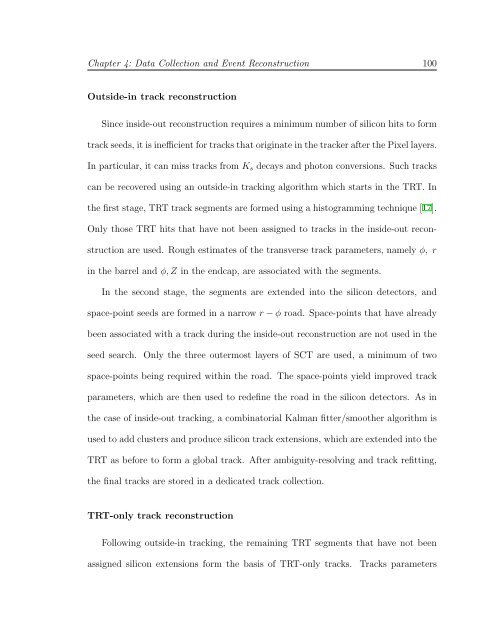Measurement of the Z boson cross-section in - Harvard University ...
Measurement of the Z boson cross-section in - Harvard University ...
Measurement of the Z boson cross-section in - Harvard University ...
You also want an ePaper? Increase the reach of your titles
YUMPU automatically turns print PDFs into web optimized ePapers that Google loves.
Chapter 4: Data Collection and Event Reconstruction 100<br />
Outside-<strong>in</strong> track reconstruction<br />
S<strong>in</strong>ce <strong>in</strong>side-out reconstruction requires a m<strong>in</strong>imum number <strong>of</strong> silicon hits to form<br />
track seeds, it is <strong>in</strong>efficient for tracks that orig<strong>in</strong>ate <strong>in</strong> <strong>the</strong> tracker after <strong>the</strong> Pixel layers.<br />
In particular, it can miss tracks from Ks decays and photon conversions. Such tracks<br />
can be recovered us<strong>in</strong>g an outside-<strong>in</strong> track<strong>in</strong>g algorithm which starts <strong>in</strong> <strong>the</strong> TRT. In<br />
<strong>the</strong> first stage, TRT track segments are formed us<strong>in</strong>g a histogramm<strong>in</strong>g technique [17].<br />
Only those TRT hits that have not been assigned to tracks <strong>in</strong> <strong>the</strong> <strong>in</strong>side-out recon-<br />
struction are used. Rough estimates <strong>of</strong> <strong>the</strong> transverse track parameters, namely φ, r<br />
<strong>in</strong> <strong>the</strong> barrel and φ, Z <strong>in</strong> <strong>the</strong> endcap, are associated with <strong>the</strong> segments.<br />
In <strong>the</strong> second stage, <strong>the</strong> segments are extended <strong>in</strong>to <strong>the</strong> silicon detectors, and<br />
space-po<strong>in</strong>t seeds are formed <strong>in</strong> a narrow r − φ road. Space-po<strong>in</strong>ts that have already<br />
been associated with a track dur<strong>in</strong>g <strong>the</strong> <strong>in</strong>side-out reconstruction are not used <strong>in</strong> <strong>the</strong><br />
seed search. Only <strong>the</strong> three outermost layers <strong>of</strong> SCT are used, a m<strong>in</strong>imum <strong>of</strong> two<br />
space-po<strong>in</strong>ts be<strong>in</strong>g required with<strong>in</strong> <strong>the</strong> road. The space-po<strong>in</strong>ts yield improved track<br />
parameters, which are <strong>the</strong>n used to redef<strong>in</strong>e <strong>the</strong> road <strong>in</strong> <strong>the</strong> silicon detectors. As <strong>in</strong><br />
<strong>the</strong> case <strong>of</strong> <strong>in</strong>side-out track<strong>in</strong>g, a comb<strong>in</strong>atorial Kalman fitter/smoo<strong>the</strong>r algorithm is<br />
used to add clusters and produce silicon track extensions, which are extended <strong>in</strong>to <strong>the</strong><br />
TRT as before to form a global track. After ambiguity-resolv<strong>in</strong>g and track refitt<strong>in</strong>g,<br />
<strong>the</strong> f<strong>in</strong>al tracks are stored <strong>in</strong> a dedicated track collection.<br />
TRT-only track reconstruction<br />
Follow<strong>in</strong>g outside-<strong>in</strong> track<strong>in</strong>g, <strong>the</strong> rema<strong>in</strong><strong>in</strong>g TRT segments that have not been<br />
assigned silicon extensions form <strong>the</strong> basis <strong>of</strong> TRT-only tracks. Tracks parameters















